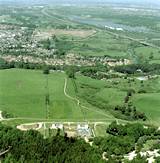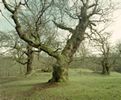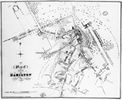 |
||||||||
| Aerial view of site of Hamilton Palace, Hamilton, South Lanarkshire | ||||||||
 © RCAHMS |
Situated in the Low Parks in the fertile valley of the River Clyde, Hamilton Palace stood at the centre of an extensive garden which, as its main axis, had a great north-south tree-lined avenue over 5km in overall length. This designed landscape may have originated in the late 17th century but was first drawn up in 1708 by Alexander Edward (1651-1708). The layout was later developed, most notably by William Adam (1689-1748), who introduced Ch‚telherault hunting lodge into the south avenue in the High Parks where it commanded a broad vista northwards across the Low Parks. |
|||||||
|
This aerial view looks northwards along the parallel lines of the great avenue from above Ch‚telherault (centre foreground), across the Avon Water on the line of Old Avon Bridge, through the modern suburbs of Hamilton, towards the site of Hamilton Palace itself. It occupied much of the western side of the patch of ground seen under development as a retail park in the middle distance. The palace stood to the left and in front of the conspicuous domed mausoleum, and to the right of the burgh of Hamilton which grew up on the slopes of the 'Hietoun' to the west of the palace. Separated from the site of the palace by the M74 motorway, the River Clyde follows a new course between the motorway and the lake of a modern country park (right background). The avenue extended an equal distance northwards from the palace across what is now a golf course to a loop in the River Clyde close to Bothwellhaugh, just visible in the far distance, where Hamilton Palace Colliery was established in 1884. |
||||||||
|
|
|
|
|
|
|
|
|
|
 Detailed
view of the palace Detailed
view of the palace |
||||||||
 William
Pettigrew plan, 1813 William
Pettigrew plan, 1813 |
||||||||
 Cadzow Oaks |
 Engraving
by John Slezer Engraving
by John Slezer |
|||||||
|
|
|
|
|
|
|
|
|
|


